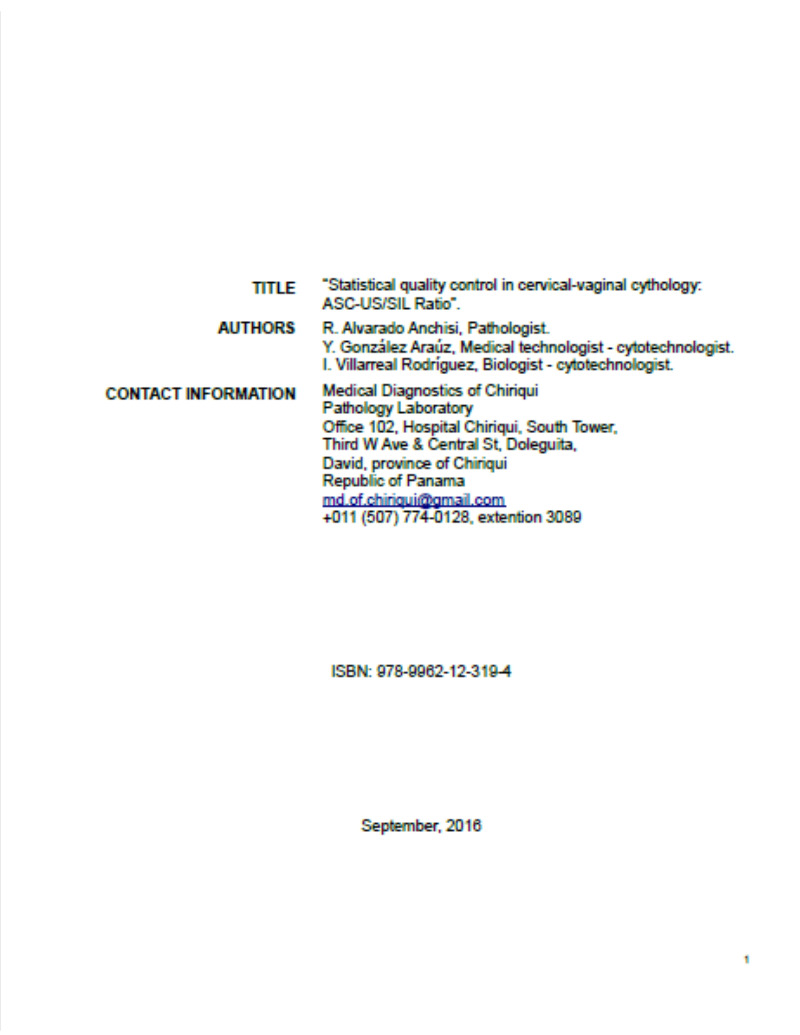
Statistical quality control in cervical-vaginal cythology - PDF-INGLES
ASC-US/SIL Ratio (electronic form)
González Araúz, Yury
Alvarado Anchisi, Rolando Alberto
Editorial:Alvarado Anchisi, Rolando Alberto
Materia:Anatomía y morfología
Clasificación:Citopatología
Público objetivo:Profesional / académico
Publicado:2016-09-01
Número de edición:1
Soporte:Digital
Formato:Pdf (.pdf)
Idioma:Inglés
Libros relacionados
Histología de fuente abierta - Alvarado Anchisi, Rolando Alberto
El gran libro del cuerpo humano (RA)
Control de calidad estadístico en citología cervico-vaginal - PAPEL - Villarreal Rodríguez, Ilagam; González Araúz, Yury; Alvarado Anchisi, Rolando Alberto
Statistical quality control in cervical-vaginal cythology - PAPEL INGLES - Villarreal Rodríguez, Ilagam; González Araúz, Yury; Alvarado Anchisi, Rolando Alberto
Reseña
Introduction Uterine cervix cancer is the second most common neoplasm in women. Of all
uterine cervix and vagina cytologies, between 0,5 and 0,6% reveal high-grade squamous
intraepithelial lesion (HSIL), and between 2 and 3% are low-grade squamous intraepithelial
lesions (LSIL). The tem ASC-US (atypical squamous cells, of undetermined significance) is a
diagnostic category, not a biological entity, that comprises inflammatory, reactive and
reparative processes. In our revision of the literature, we found that ASC-US diagnosis
comprises between 1,6 and 9% of the diagnosis, with an average around 5%. Other authors
have employed with success the use of a ration between ASC-US and SIL as statistical
quality control tool, whose value should not surpass 3,0.
Research methods It's a descriptive, retrospective study, based on the total of cervicovaginal
cytologies processed and diagnosed in this lab, since opening on July 1st, 2008 until
December 31st, 2015.
Results We found a total of 58,289 cervico-vaginal exfoliative cytologies. From which 974
were diagnosed as ASC-US and 925 as SIL. The ASC-US/SIL ratio was, on average 1,16,
with a standard deviation of 0,31. The range of the ASC-US/SIL ratio was between 0,69 and
1,67. The ASC-US diagnoses represented 1,67%, whereas the SIL diagnosis were 1,59% of
all cases. ASC-US had an average of 2,06%, with a standard deviation of 0,99%, in a range
between 0,67 and 4,09%. SIL had an average of 1,79%, with a standard deviation of 0,68%,
in a range between 0,69 and 2,79%.
Discussion We found yearly variations of ASC-US/SIL ratio, that we attribute to human
factors such as work load. In 2010, ASC-US/SIL ratio was set below one standard deviation
from average, and in 2012 it was set above one standard deviation from average. Our ASCUS
and SIL percentages were well below figures found in bibliographical references. Both
figures also showed yearly variations. There was overdiagnosis of ASC-US in 2008, and of
SIL in 2008 and 2010.
Conclusion To the extent of what we've been able to investigate, this is the first article about
statistical quality control for uterine cervix and vagina cytology in Panama. Nevertheless, we
still believe it is important to compare our findings with other labs willing to publish their
results, to determine is ours constitute the statistical rule of the region or if they are an
statistical annomay, favorable or disfavorable.




